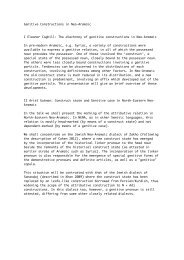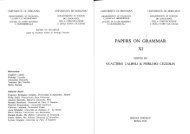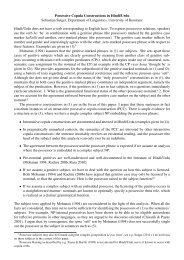Temporal, Causal and Concessive Clauses with the particle wo in ...
Temporal, Causal and Concessive Clauses with the particle wo in ...
Temporal, Causal and Concessive Clauses with the particle wo in ...
You also want an ePaper? Increase the reach of your titles
YUMPU automatically turns print PDFs into web optimized ePapers that Google loves.
Iris Bräun<strong>in</strong>g<br />
iris.braeun<strong>in</strong>g@uni-konstanz.de<br />
University of Konstanz<br />
Department of L<strong>in</strong>guistics<br />
Abstract: PhD Workshop May 2013<br />
<strong>Temporal</strong>, <strong>Causal</strong> <strong>and</strong> <strong>Concessive</strong> <strong>Clauses</strong> <strong>with</strong> <strong>the</strong> <strong>particle</strong> <strong>wo</strong> <strong>in</strong> Alemannic<br />
The <strong>particle</strong> <strong>wo</strong> is known for its multifunctional occurrence <strong>in</strong> Alemannic:<br />
1. der Mo <strong>wo</strong> se<strong>in</strong>e Schu verlora hot<br />
<strong>the</strong> man PRT his shoes lost has<br />
‚The man who lost his shoes’ (Br<strong>and</strong>ner, Bräun<strong>in</strong>g, to appear)<br />
2. Wo i am Samschdich akomme ben, hot d Sonn no gschiena<br />
PRT I on Saturday arrived was, has <strong>the</strong> sun still shone<br />
‚When I arrived on Saturday <strong>the</strong> sun was still sh<strong>in</strong><strong>in</strong>g’<br />
(Bräun<strong>in</strong>g, 2009)<br />
3. Wo se d Kischda <strong>in</strong>s Auto eiglada händ, hots grägnt<br />
PRT <strong>the</strong>y <strong>the</strong> boxes <strong>in</strong>to-<strong>the</strong> car loaded have, has-it ra<strong>in</strong>ed<br />
‚While <strong>the</strong>y have been load<strong>in</strong>g <strong>the</strong> boxes <strong>in</strong>to <strong>the</strong> car it ra<strong>in</strong>ed all <strong>the</strong> time‘<br />
(Bräun<strong>in</strong>g, 2009)<br />
In (1) <strong>the</strong> <strong>particle</strong> <strong>wo</strong> is used to <strong>in</strong>troduce a relative clause, <strong>in</strong> (2) <strong>and</strong> (3) it replaces a temporal<br />
conjunction (St<strong>and</strong>ard German als (when) <strong>and</strong> während (while)).<br />
In addition <strong>the</strong> <strong>particle</strong> is also found <strong>in</strong> sentences that have a causal or concessive read<strong>in</strong>g:<br />
4. Ha Die (.) die will ständig komme und schwätze, schwätze, schwätze,<br />
Ha DET DET wants always come <strong>and</strong> talk, talk, talk<br />
<strong>wo</strong> i doch koi Zeit han für so ebbes.<br />
PRT I PRT no time have for such a th<strong>in</strong>g<br />
‚She always wants to come <strong>and</strong> talk but I have no time'<br />
(Günthner, 2002: 311)<br />
5. Tr<strong>in</strong>k lieber nix <strong>wo</strong> du (doch) so erkältet bisch<br />
dr<strong>in</strong>k ra<strong>the</strong>r noth<strong>in</strong>g PRT you PRT so cold are<br />
‚If you have a cold, it <strong>wo</strong>uld be better not do dr<strong>in</strong>k alcohol'<br />
(Güntner, 2002: 311)<br />
The data <strong>in</strong> 1-5 show that relative clauses as well as temporal, causal <strong>and</strong> concessive clauses can<br />
be <strong>in</strong>troduced <strong>with</strong> a <strong>particle</strong> <strong>wo</strong>, that is homophone <strong>with</strong> <strong>the</strong> German local adverb <strong>wo</strong> mean<strong>in</strong>g<br />
where. How <strong>the</strong> <strong>particle</strong> strategy <strong>with</strong> <strong>wo</strong> evolved <strong>in</strong> relative clauses <strong>and</strong> how it can be analyzed<br />
syntactically has been described <strong>in</strong> Br<strong>and</strong>ner, Bräun<strong>in</strong>g (to appear). As for <strong>the</strong> <strong>particle</strong> strategy<br />
<strong>in</strong> Alemannic relative clauses it has been assumed that <strong>wo</strong> diachronically can be traced back to<br />
<strong>the</strong> equative <strong>particle</strong> so that is found <strong>in</strong> Early New High German relative clauses like (dër Sache<br />
sô ir me<strong>in</strong>ent / The th<strong>in</strong>g so you mean, Paul 1920:238) <strong>and</strong> it has been claimed that <strong>the</strong> <strong>particle</strong><br />
<strong>wo</strong> is <strong>the</strong> wh-counterpart of so <strong>and</strong> thus <strong>the</strong> semantic of both structures equatives <strong>and</strong> restrictive<br />
relatives <strong>in</strong>troduced by a <strong>particle</strong> have a similar structure see (6) <strong>and</strong> (7).<br />
Equative structure:<br />
6. Hans läuft (so) schnell wie der W<strong>in</strong>d<br />
Hans runs (so) fast as <strong>the</strong> w<strong>in</strong>d<br />
‚Hans runs as fast as <strong>the</strong> w<strong>in</strong>d blows’
6' Hans' runn<strong>in</strong>g has a rapidity (= x) <strong>and</strong> <strong>the</strong> w<strong>in</strong>d has a rapidity (= y),<br />
whereby wie states that x = y<br />
Transferred to a restrictive relative clause <strong>the</strong> paraphrase could be formulated as <strong>in</strong> (7):<br />
7. Des Buech <strong>wo</strong> ich g'lese ha liit uff em Tisch<br />
<strong>the</strong> book PRT I read have lies on <strong>the</strong> table<br />
‚The book that I read lies on <strong>the</strong> table'<br />
ALM<br />
7‘ x is a book <strong>and</strong><br />
7‘‘ I read someth<strong>in</strong>g (=y)<br />
→ Due to <strong>the</strong> <strong>particle</strong>s so or <strong>wo</strong> <strong>the</strong> follow<strong>in</strong>g relation is established: x = y<br />
(see also Br<strong>and</strong>ner, Bräun<strong>in</strong>g, to appear)<br />
There is supposed to be a common structure between equatives <strong>and</strong> restrictive relative clauses<br />
ly<strong>in</strong>g <strong>in</strong> <strong>the</strong> conjunction of t<strong>wo</strong> elements. In (6) it is a conjunction (equation) of properties<br />
whereas <strong>in</strong> (7) <strong>the</strong> conjunction comb<strong>in</strong>es <strong>the</strong> t<strong>wo</strong> elements for which <strong>the</strong> property holds<br />
(compare also Br<strong>and</strong>ner, Bräun<strong>in</strong>g (to appear) for a detailed analysis).<br />
The presentation will discuss <strong>the</strong> follow<strong>in</strong>g open questions: How to analyze <strong>the</strong> occurrence of<br />
<strong>the</strong> <strong>particle</strong> <strong>wo</strong> <strong>in</strong> temporal, concessive <strong>and</strong> causal sentences. What is <strong>the</strong> function of <strong>the</strong> <strong>particle</strong><br />
<strong>in</strong> <strong>the</strong>se structures? How is <strong>the</strong> temporal, causal or concessive read<strong>in</strong>g possible if <strong>the</strong>re is no<br />
St<strong>and</strong>ard German conjunction <strong>and</strong> can we br<strong>in</strong>g toge<strong>the</strong>r <strong>the</strong> analysis for restrictive relative<br />
clauses <strong>with</strong> <strong>the</strong> <strong>particle</strong> structure <strong>in</strong> temporal, causal <strong>and</strong> concessive clauses?<br />
References:<br />
Br<strong>and</strong>ner, Ellen, Bräun<strong>in</strong>g, Iris (to appear). Relative <strong>wo</strong> <strong>in</strong> Alemannic: only a complementizer?<br />
L<strong>in</strong>guistische Berichte.<br />
Bräun<strong>in</strong>g, Iris. 2009. Wo als funktionale Kategorie: e<strong>in</strong>e Studie im Schwäbisch-Alemannischen<br />
Dialekt, MA Thesis. Fachbereich Sprachwissenschaft, Universität Konstanz.<br />
Günthner, Susanne. 2002. Zum kausalen und konzessiven Gebrauch des Konnektors <strong>wo</strong> im<br />
gesprochenen Umgangsdeutsch. Zeitschrift für Germanistische L<strong>in</strong>guistik 30:310-341.<br />
Paul, Hermann. 1920. Deutsche Grammtik IV. Syntax (2. Hälfte). Halle (Saale): Niemeyer.







